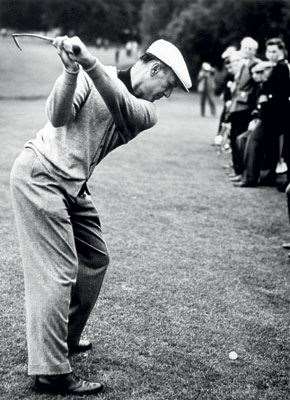He even wrote specific instructions for it, but Ben Hogan is said to still be the only man to ever perfect the golf swing.
He even wrote specific instructions for it, but Ben Hogan is said to still be the only man to ever perfect the golf swing.
 Tiger Woods has conceded that Ben Hogan was one of only two golfers, who “owned” his swing. Image: Getty Images
Tiger Woods has conceded that Ben Hogan was one of only two golfers, who “owned” his swing. Image: Getty ImagesWho ever heard of such a preposterous thing as the perfect golf swing? It’s a mere proposition, even in the age of biomechanics. Like fame and fortune, like victory and success, it often takes a fade just when its beneficiary thinks he finally has it in his grip. But Ben Hogan had it nailed.
Nicklaus and Woods agree on that point. Nicklaus went one further: Hogan was the best shot-maker all through the bag – all 14 clubs – the world has seen. To this day, we don’t know whether his legacy was to demonstrate just how easy the swing was to master, or whether he only served to deepen its mystery.
Certainly we know that in 1912, around the time Einstein was rolling out another Earth-shaking hypothesis, a man was born who gave rise to an entire field of study: golf swing theory. William Ben Hogan was born in Stephenville, Texas. No one knows whether it was the suicide of his father when he was nine – Ben heard the gunshot – that led him to seek the serenity of the golf course and answer the challenge of a game many consider the most difficult of all, but Hogan was soon a professional.
We can talk about the physics of hip torque. Hip and shoulder dynamic. Bottom hand and the top hand. The elbows and the position of the head. These are mere matters of technique. If we could capture Hogan’s mastery in words, perhaps everyone would be able to do it. It’s not that easy.
Tiger Woods conceded that Hogan was one of only two golfers in history (the other was Moe Norman) who “owned” his swing. The patent he put on it cannot be broken, it seems. To watch Hogan play a game was like watching a spider spin a web. To watch him swing a club was like watching a fish swim.
The key to Hogan’s success was failure. It was 1940, and he was 28, when he finally won a pro tournament. Then he won three in a row. Before that, he had a habitual hook. The key to his genius was love. Hogan, a mentally-tough competitor, couldn’t wait to get up in the mornings and hit balls. His own shortcomings fascinated him.
In order to correct his hook, he practised a number of techniques. The first was “cupping under” – cupping the left wrist at the top of his swing and making his left-hand grip “weaker” by moving his thumb toward the top of the grip rather than wrapping it around the right side. However, he revealed, he used his right knee to initiate the swing. That was crucial to the movement of his left wrist. It produced a “late” swing, which gave rise to the famous Hogan fade – an antidote to the hook. Its flight was lower than that of most top players, shaping from left to right. The movement of his right arm was as connected to his right hip as that of a boxer throwing the perfect punch. To be early, to be late, is to negate; to hook or to slice. Hogan’s timing was unbeatable.
Hogan’s grip always ensured his club face was slightly open, which prevented any possibility of the hook bedevilling his game. Hogan had many unusual habits. Like that other golfing genius, Moe Norman, he never wore gloves. He felt they nullified the feel of his enormous (for a small man) powerful hands for the club. It’s often said that the one clue to Hogan’s consistency and accuracy was pronation: focusing the weight of his body on the insides of his feet.
He was said to have “invented” real, focused practice, based on repetition of a technique that seemed to defy most of today’s wisdom. He did his best to impart it, in his Five Lessons: The Modern Fundamentals Of Golf, but seemed only to succeed in creating a spate of slicers among his disciples. Many professionals, aspiring professionals and outright champions continue to pore over books dissecting Hogan’s game.
With it he won the only British Open he entered, in 1953; the PGA in 1946 and ‘48, the Masters in ‘51 and ’53; five US Opens (counting the 1942 Hale America National Open). He won in 1948, ‘50 , ‘51 and ‘53. He didn’t play in 1949, when a car crash almost destroyed him physically. He won 68 professional tournaments.
Some sporting innovators leave a legacy of permanent change, because their particular brand of innovation can be replicated. Hogan’s swing was not that kind of innovation. Whether it was the idiosyncratic mechanics of his body, the distinctive quirks of his mind, or both, his swing was inimitable.
But it was perfectly repeatable – if you were Ben Hogan!
– Robert Drane
Related Articles

Perfectly Fitting: The ultimate fitting guide

International Spotlight: Omanu Golf Club













